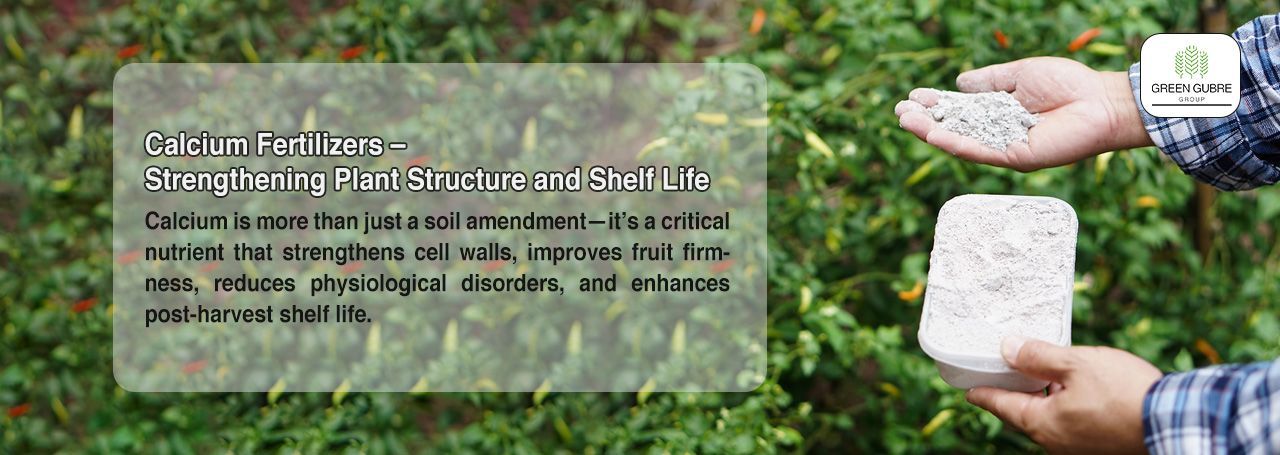Calcium Fertilizers – Strengthening Plant Structure and Shelf Life
Calcium Fertilizers – Strengthening Plant Structure and Shelf Life

Introduction: The Structural Backbone of Healthy Crops
Calcium is more than just a soil amendment—it’s a critical nutrient that strengthens cell walls, improves fruit firmness, reduces physiological disorders, and enhances post-harvest shelf life. Often underutilized, calcium plays a crucial role in maintaining plant structural integrity and stress tolerance, particularly in fruits and vegetables. As high-value crops dominate modern agriculture, calcium fertilizers are becoming a key tool for growers aiming to produce resilient, market-ready produce.
1. Why Crops Need Calcium
Calcium is vital for:
- Cell Wall Stability – Supports pectin formation and structural strength.
- Root and Shoot Growth – Promotes the development of new root tips and meristems.
- Stress Resistance – Improves tolerance to drought, salinity, and heat.
- Disease Protection – Reduces vulnerability to blossom-end rot, cracking, and fungal infections.
Unlike other nutrients, calcium is immobile in plants. This means young tissues suffer first from deficiency, resulting in tip burn in lettuce, bitter pit in apples, or blossom-end rot in tomatoes and peppers.
2. Types of Calcium Fertilizers
Growers can apply calcium through soil or foliar routes using various sources:
- Calcium Nitrate (Ca(NO₃)₂) – Fast-acting, water-soluble form ideal for fertigation.
- Calcium Chloride – An effective foliar spray for improving fruit firmness.
- Gypsum (CaSO₄) – Improves calcium in soils with minimal pH effect.
- Lime (CaCO₃) – Long-term solution for acid soil correction and calcium replenishment.
- Chelated Calcium – For high-efficiency foliar application, especially in alkaline or saline soils.
🔗 University of California – Calcium Fertilization Guidelines
3. Crops and Regions That Benefit Most
Calcium nutrition is essential in:
- Tomato, Pepper, Melon – For preventing blossom-end rot and fruit cracking
- Apples, Grapes, Citrus – To reduce post-harvest disorders like bitter pit and improve firmness
- Leafy Greens (Lettuce, Cabbage) – To avoid tip burn and maintain cell turgidity
- Root Crops (Carrot, Beet, Potato) – For tuber development and resistance to rotting
Regions with acidic soils or low organic matter—such as parts of Africa, Southeast Asia, and South America—commonly experience calcium deficiency.
4. Key Benefits of Calcium Fertilization
- Improved Yield and Market Quality – Higher weight, firmness, and visual appeal
- Post-Harvest Shelf Life – Longer storage potential, critical for exports
- Soil Structure – Improves soil aggregation and water penetration (especially via gypsum)
- Reduced Crop Loss – Lower susceptibility to calcium-related physiological disorders
5. Green Gubre Group – Fortifying Agriculture with Calcium
At Green Gubre Group, we supply a full range of calcium fertilizers designed for:
- Greenhouse, orchard, and field applications
- Soil and foliar application in acid-prone and high-value cropping zones
- Custom calcium nitrate and gypsum blends
- Technical guidance on compatibility, scheduling, and dosage
Our calcium nutrition programs are tailored to help farmers meet both yield targets and quality expectations.




